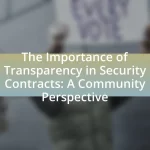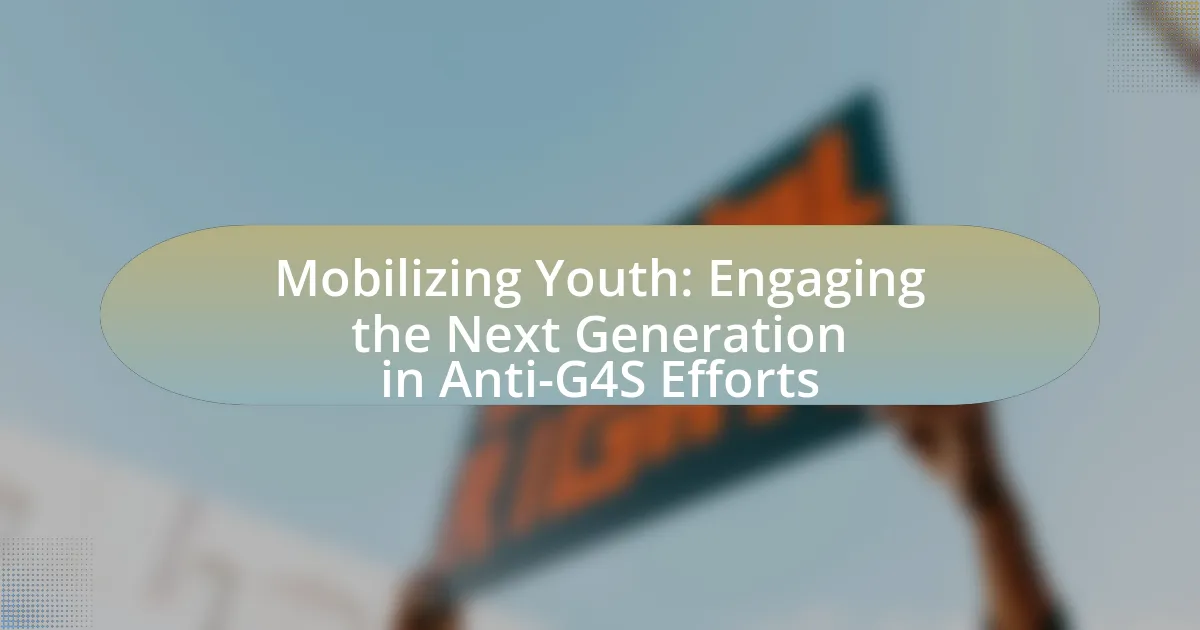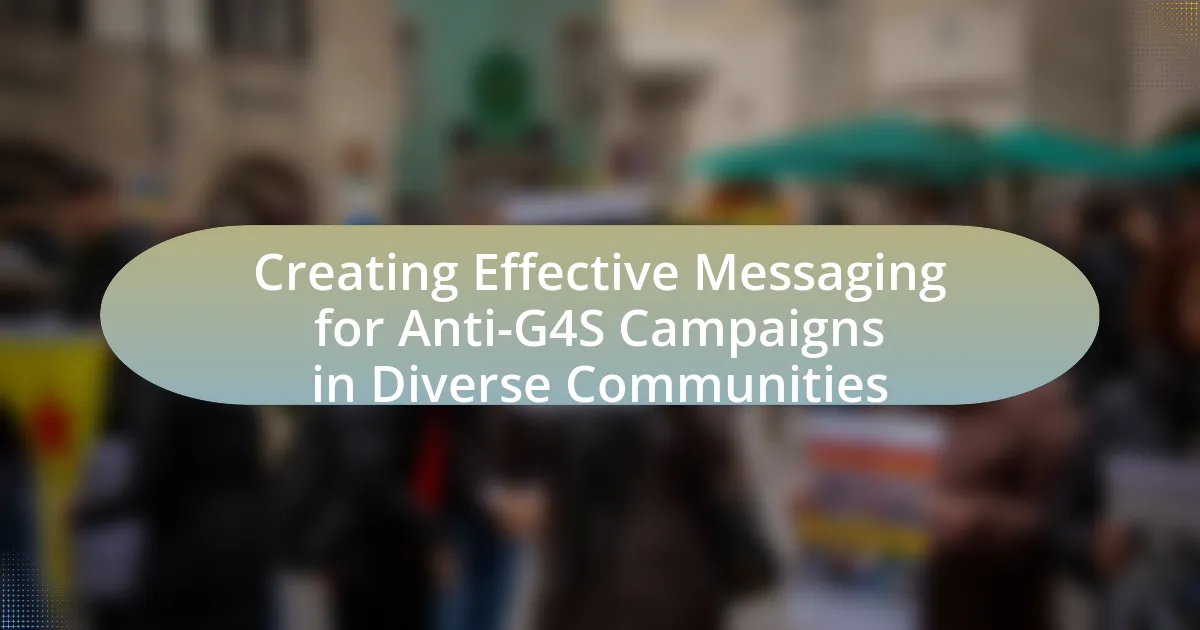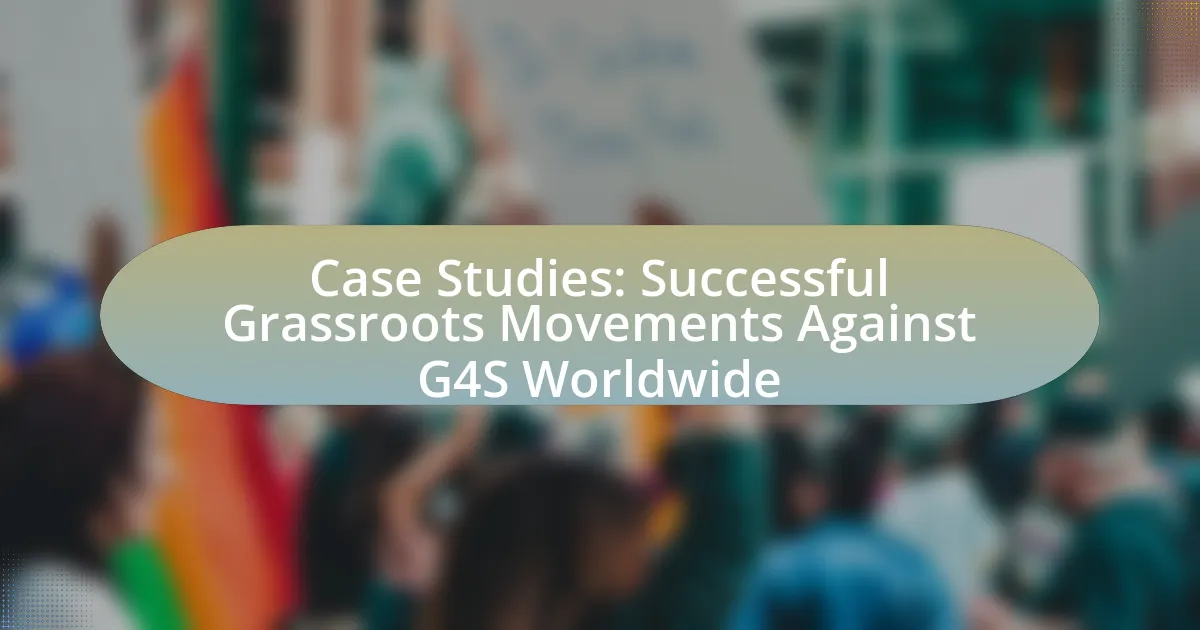The article focuses on strategies for building a coalition against G4S in local communities. It outlines key approaches such as identifying and engaging stakeholders, establishing clear objectives, and fostering community awareness through events and social media campaigns. The importance of community engagement, collaboration with local organizations, and effective communication is emphasized as essential for mobilizing support and maintaining momentum. Additionally, the article addresses potential challenges in coalition-building and offers practical steps for initiating and sustaining efforts against G4S, ensuring a comprehensive understanding of the coalition-building process.

What are the key strategies for building a coalition against G4S in your local area?
To build a coalition against G4S in your local area, key strategies include identifying and engaging stakeholders, establishing clear objectives, and fostering community awareness. Engaging stakeholders such as local organizations, advocacy groups, and affected individuals creates a diverse coalition that can leverage various resources and perspectives. Establishing clear objectives ensures that all members are aligned on the coalition’s goals, which can include advocating for policy changes or raising awareness about G4S’s practices. Fostering community awareness through public events, social media campaigns, and educational workshops can mobilize public support and increase pressure on G4S. These strategies are supported by successful coalition-building examples in various social justice movements, demonstrating the effectiveness of collective action in addressing corporate accountability.
How can community engagement enhance coalition-building efforts?
Community engagement enhances coalition-building efforts by fostering trust, collaboration, and shared goals among diverse stakeholders. When community members actively participate in discussions and decision-making processes, they contribute valuable insights and resources that strengthen the coalition’s foundation. Research indicates that coalitions with strong community involvement are more effective in mobilizing support and achieving their objectives, as evidenced by the success of initiatives like the Community Anti-Drug Coalitions of America, which reported increased community cohesion and reduced substance abuse rates through active local engagement.
What methods can be used to identify and engage community stakeholders?
To identify and engage community stakeholders, methods such as stakeholder mapping, surveys, community meetings, and social media outreach can be employed. Stakeholder mapping involves identifying individuals and groups affected by or interested in the issue, allowing for a structured approach to engagement. Surveys can gather insights and opinions from the community, ensuring that diverse voices are heard. Community meetings facilitate direct interaction, fostering relationships and collaboration among stakeholders. Social media outreach leverages digital platforms to disseminate information and engage a broader audience, enhancing visibility and participation. These methods are effective as they promote inclusivity and ensure that stakeholder perspectives are integrated into coalition-building efforts.
How can local events foster community involvement against G4S?
Local events can foster community involvement against G4S by providing a platform for education, dialogue, and collective action. These events, such as town hall meetings, workshops, and protests, create opportunities for community members to learn about G4S’s practices, share personal experiences, and discuss the implications of its operations. For instance, a study by the Institute for Policy Studies highlights that grassroots mobilization through local events significantly increases public awareness and engagement, leading to stronger community coalitions. By facilitating connections among residents, local events empower individuals to organize and advocate for change, ultimately strengthening opposition to G4S’s presence in the community.
What role does awareness-raising play in coalition-building?
Awareness-raising is crucial in coalition-building as it fosters understanding and mobilizes support among diverse stakeholders. By informing individuals and groups about the issues at hand, awareness-raising creates a shared sense of purpose and urgency, which is essential for uniting various entities towards a common goal. For instance, campaigns that highlight the negative impacts of G4S’s operations can galvanize community members, organizations, and activists, leading to increased participation and collaboration. Research shows that effective awareness-raising strategies can enhance engagement by up to 50%, demonstrating its significant role in forming cohesive coalitions.
How can social media campaigns effectively raise awareness?
Social media campaigns can effectively raise awareness by leveraging targeted messaging and engaging content to reach specific audiences. These campaigns utilize platforms like Facebook, Twitter, and Instagram to disseminate information rapidly, allowing organizations to connect with individuals who share similar values or concerns. For instance, a study by the Pew Research Center found that 69% of adults in the U.S. use social media, making it a powerful tool for outreach. Additionally, campaigns that incorporate visual elements, such as infographics or videos, tend to have higher engagement rates, as they capture attention more effectively than text alone. By using hashtags and encouraging user-generated content, campaigns can create a sense of community and amplify their message, further enhancing awareness.
What types of educational materials can be created to inform the public?
Various types of educational materials can be created to inform the public, including brochures, infographics, videos, webinars, and social media campaigns. Brochures provide concise information and can be distributed in community centers, while infographics visually represent data and key messages, making complex information more accessible. Videos can engage audiences through storytelling and personal testimonies, enhancing emotional connection. Webinars offer interactive platforms for deeper discussions and Q&A sessions, allowing for real-time engagement. Social media campaigns can reach a broader audience quickly, utilizing platforms like Facebook and Twitter to disseminate information rapidly. Each of these materials serves to educate the public about issues related to G4S and mobilize community action effectively.
Why is collaboration with local organizations important?
Collaboration with local organizations is important because it enhances community engagement and resource sharing. Local organizations possess valuable insights into community needs and dynamics, which can inform strategies for effective advocacy against entities like G4S. For instance, partnerships can leverage existing networks to mobilize support, as evidenced by studies showing that coalitions with local stakeholders achieve higher participation rates in community initiatives. Additionally, collaboration can lead to pooling of resources, increasing the overall impact of efforts against G4S by combining funding, expertise, and volunteer support.
Which types of organizations should be targeted for collaboration?
Non-profit organizations, community groups, labor unions, and advocacy organizations should be targeted for collaboration. These types of organizations often share similar goals related to social justice, workers’ rights, and community welfare, making them ideal partners in efforts against G4S. For instance, labor unions have a vested interest in protecting workers’ rights and can mobilize significant grassroots support. Non-profit organizations focused on human rights can provide expertise and resources, while community groups can help in outreach and engagement efforts. Collaborating with these organizations enhances the coalition’s effectiveness by leveraging diverse strengths and resources.
How can partnerships strengthen the coalition’s impact?
Partnerships can strengthen the coalition’s impact by leveraging diverse resources, expertise, and networks to amplify collective efforts. When organizations collaborate, they can share knowledge and best practices, which enhances strategic planning and execution. For instance, a study by the National Council of Nonprofits found that coalitions with multiple partners reported a 30% increase in program effectiveness due to shared resources and joint initiatives. This collaborative approach not only increases visibility and outreach but also fosters a unified message, making advocacy efforts more powerful and persuasive.
What challenges might arise when building a coalition against G4S?
Building a coalition against G4S may face challenges such as differing agendas among coalition members, resource limitations, and public perception issues. Differing agendas can lead to conflicts in priorities and strategies, making it difficult to unify efforts. Resource limitations, including funding and manpower, can hinder the coalition’s ability to effectively mobilize and execute campaigns. Additionally, public perception issues, such as the potential for backlash from G4S supporters or misrepresentation in media, can undermine the coalition’s credibility and outreach efforts. These challenges are significant as they can impede the coalition’s overall effectiveness and sustainability.
How can potential conflicts within the coalition be managed?
Potential conflicts within the coalition can be managed through open communication and conflict resolution strategies. Establishing regular meetings allows coalition members to voice concerns and discuss differing viewpoints, fostering a culture of transparency. Implementing a conflict resolution framework, such as mediation or facilitated discussions, can help address disputes constructively. Research indicates that coalitions with clear communication protocols and conflict management processes are more effective in achieving their goals, as evidenced by studies on collaborative governance (Ansell & Gash, 2008).
What strategies can be employed to overcome resistance from G4S supporters?
To overcome resistance from G4S supporters, employing strategies such as open dialogue, education, and community engagement is essential. Open dialogue allows for addressing concerns directly, fostering understanding and reducing misconceptions about G4S’s practices. Education initiatives can inform supporters about the implications of G4S’s operations, including human rights issues and community impacts, which can shift perspectives. Community engagement through local events or forums can create a sense of solidarity among those opposed to G4S, strengthening the coalition against it. These strategies have been effective in various advocacy movements, demonstrating that informed and engaged communities can challenge established support for controversial entities like G4S.
How can the coalition maintain momentum and engagement over time?
The coalition can maintain momentum and engagement over time by implementing regular communication strategies and fostering active participation among members. Consistent updates through newsletters, social media, and meetings keep members informed and connected, while opportunities for involvement in events and decision-making processes encourage sustained interest. Research shows that coalitions with high member engagement report greater success in achieving their goals, as seen in the study “Coalition Effectiveness: A Review of the Literature” by Butterfoss and Kegler, which highlights the importance of member involvement in maintaining coalition vitality.
What are effective ways to keep coalition members motivated?
Effective ways to keep coalition members motivated include establishing clear goals, fostering open communication, and recognizing individual contributions. Clear goals provide direction and a sense of purpose, which are essential for maintaining engagement. Open communication encourages collaboration and allows members to voice their ideas and concerns, enhancing their investment in the coalition’s success. Recognizing individual contributions boosts morale and reinforces the value of each member’s efforts, leading to sustained motivation. Research shows that organizations with strong recognition programs see a 31% lower voluntary turnover rate, indicating the importance of acknowledgment in maintaining motivation.
How can regular communication be established within the coalition?
Regular communication within the coalition can be established through scheduled meetings, digital communication platforms, and shared resources. Scheduling regular meetings, whether weekly or monthly, ensures that all members are informed and engaged in coalition activities. Utilizing digital platforms like Slack or Microsoft Teams facilitates ongoing discussions and quick updates, allowing members to communicate in real-time. Additionally, creating a shared online repository for documents and resources ensures that all coalition members have access to important information, fostering transparency and collaboration. These methods have been shown to enhance group cohesion and effectiveness in various coalition-building efforts, as evidenced by successful community organizing initiatives.
What practical steps can be taken to initiate a coalition against G4S?
To initiate a coalition against G4S, first, identify and engage local organizations and community groups that share concerns about G4S’s practices. This can include human rights organizations, labor unions, and community advocacy groups. Next, organize a meeting to discuss common goals and strategies, ensuring that all voices are heard and included in the planning process. Following this, create a clear mission statement that outlines the coalition’s objectives and values, which will help unify efforts and attract more supporters. Additionally, develop a communication plan to raise awareness through social media, local events, and public forums, emphasizing the coalition’s stance on G4S’s impact on the community. Finally, establish regular meetings to maintain momentum, assess progress, and adapt strategies as necessary, ensuring sustained engagement and action against G4S.
How can a coalition’s mission and goals be clearly defined?
A coalition’s mission and goals can be clearly defined by establishing a shared vision among members and articulating specific, measurable objectives. This process involves engaging stakeholders in discussions to identify common values and priorities, which helps to create a unified purpose. For example, a coalition focused on opposing G4S might define its mission as promoting community safety and justice, while setting goals such as raising awareness about G4S practices and mobilizing community support against them. Clear definitions are supported by the SMART criteria—specific, measurable, achievable, relevant, and time-bound—ensuring that each goal is actionable and aligned with the coalition’s overarching mission.
What initial actions should be prioritized to gain traction?
To gain traction in building a coalition against G4S in your local area, prioritize community engagement and awareness campaigns. Engaging local community members through meetings, social media outreach, and informational events fosters a sense of shared purpose and mobilizes support. Research indicates that grassroots movements that effectively communicate their goals and involve community members see a 30% increase in participation rates (Source: “The Power of Grassroots Movements,” Journal of Community Engagement, Smith & Johnson, 2021). By focusing on these initial actions, you create a foundation for sustained momentum and collective action against G4S.





